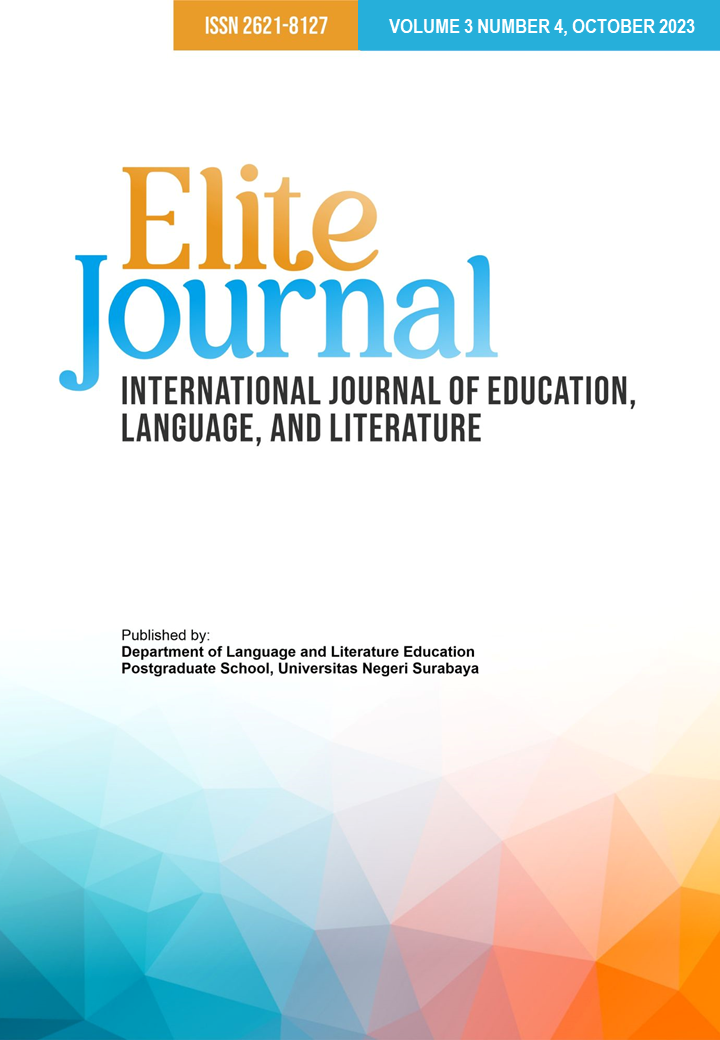THE EFFECTIVENESS OF BLENDED LEARNING MODEL IN TEACHING WRITING NARRATIVE TEXT TO THE ELEVENTH GRADE STUDENTS AT SMA NEGERI 5 MODEL LUBUKLINGGAU
DOI:
https://doi.org/10.26740/elitejournal.v3n4.p50-62Keywords:
Blended Learning, Narrative Text, WritingAbstract
The purpose of this research was to find out the empirical evidence of the student's effectiveness in writing narrative text by using WhatsApp in the Blended Learning model on students' writing abilities. This research used a Pre-Experimental method. The sample in this research was 34 students (XI MIPA 1) taken by cluster sampling. The pre-experimental class has given the treatments using WhatsApp in Blended Learning, Pre-test was given before giving treatments. The result showed as follows: first, the pre-test score showed that the average score was 44.73. After being given treatments, a post-test was given. The post-test result showed that the average score was 84.35. Second, the sample score of the independent T-test shows the significant value (2-tailed) is 5.41 1.693. In other words, (Ho) was rejected and (Ha) was accepted. In short, it can be announced that students who write narrative text using WhatsApp in the Blended Learning model are effective. So, it can be concluded that WhatsApp in Blended Learning was effective to the eleventh-grade students at SMA N 5 Model Lubuklinggau in academic year 2022/2023.
References
Abdulah, W. (2018). Model blended learning dalam meningkatkan efektifitas pembelajaran. E-journal. doi: https://doi.org/10.32806/jf.v7i7.3169
Adi, S. & Fathoni, A. F. (2019). Development of learning model based on blended learning in sports school. Advances in Social Science, Education and Humanities Research, 362, 8-12.
Arikunto, S. (2019). Prosedur Penelitian. Jakarta: Rineka Cipta.
Heaton, J. B. (1975). Writing English Language Test. London: Logman.
Helms, J. L. (2014). Comparing students performance in online and face to face delivery modalities. Journal of Asynchronous Learning Networks, 18(1), 1-14.
Herbert, C., Velan, G. M., Pryor, W. M., & Kumar, R. K. (2017). A model for the use of blended learning in large group teaching sessions. BMC Medical Education, 17(197), 1-11.
Hughes, A (2003). Testing for language teachers (2nd Edition). UK: Cambridge University.
Isnawan, M. G. (2020). Kuasi exsperimen. Indonesia: Nashir Al-Kutub.
Lai, Y. C & Peng, L. H. (2019). Effective teaching and activities of excellent teachers for the sustainable development of higher design education. Sustainability, 12(28), 1-27.
Macdonald, J. (2008). Blended Learning and Online Tutoring Planning Learner Support and Activity Design. England: Gower.
Manshur, F. M., & Husni. (2020). Promoting religious moderation through literary-based learning: a quasi-experimental study. International Journal of Advanced Sclence and Technology, 29(6), 5849-5855.
Moses, R. N & Mohamad, M. (2019). Challenges faced by students and teachers on writing skills in ESL contexts: A literature review. Creative Education, 10, 3385-3391.
Picciano, A.G., Dziuban, C. D., & Graham, C. R. (2014). Blended learning. New York: Routledge.
Rahman A., A. M., Azmi, M. N. L., Hassan, I. (2020). Improvement of English writing skills through blended learning among university students in Malaysia. Universal Journal of Educational Research, 8(12), 7694-7701. doi: 10.13189/ujer.2020.082556
Rahmat, N. A (2020). Thinking about thinking in writing. European Journal of literature, language and linguistics studies, 3(4), 20-37.
Sequeira, A. H., (2012). Introduction to concepts of teaching and learning. Social Sciences Education E-journal. https://ssrn.com/abstract=2150166
Shih, R. C. (2011). Can Web 2.0 technology assist college students in learning English writing? Integrating Facebook and peer assessment with blended learning. Australasian Journal of Educational Technology, 27(5), 829-845.
Sriwahyuni, A. (2020). The effectiveness of blended learning model on students writing compotence. Universitas Muhammadiyah Makasar.
Stein, J., & Graham, C. R. (2014). Essentials for Blended Learning a Standards-based Guide. New York: Routledge.
Sugiyono, (2016). Metode Penelitian Kuantitatif, Kualitatif dan R&D. Bandung: Alfabeta.
Thorne, K. (2003). Blended Learning: How to Integrate Online and Traditional Learning. UK: Kogan Page.
Wandira, S. (2020). The characteristics of cohesion in maling kundang narrative text. SMCC Higher Education Research Journal, 7, 157-175
Downloads
Published
How to Cite
Issue
Section
License
Copyright (c) 2023 Rialisa Triananda, Maria Ramasari, Dewi Syafitri

This work is licensed under a Creative Commons Attribution 4.0 International License.
 Abstract views: 94
,
Abstract views: 94
, PDF Downloads: 83
PDF Downloads: 83





